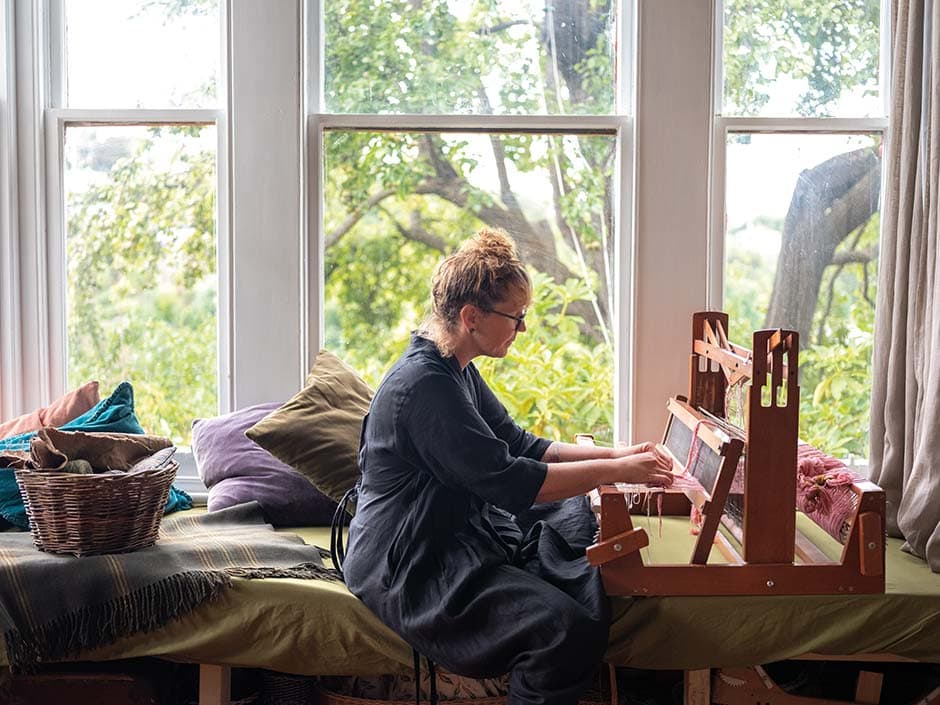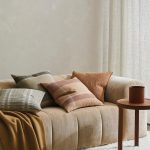Georgina May Young has always been drawn to textiles and patterns, inspired in part by her grandmother, who was an incredible maker, and her aunties too. Through her early studies of Māori art and craft at Rotorua’s Waiariki Institute of Technology, she fostered a love of weaving and working with harakeke/flax. In her 20s, she screen-printed clothing and made band tees, zines and record covers that were all hand-stitched. Today, she loves to work with texture and in a repetitive way, and says that since she seems unable to make anything that’s not labour-intensive, embroidery and weaving have become her chosen art forms.

Georgina, you grew up in Ōpōtiki and Rotorua, and now live in Ōtepoti/Dunedin — do these places influence what you’re making? Āe! I’m really inspired by home and my connection
to Ōpōtiki; much of my whānau are in the Eastern Bay of Plenty, and I still get homesick. I feel my connection to whenua through my Te Whakatōhea and Te Ūpokorehe whakapapa all the time, so it’s inevitably in my work. My adoration for the ngahere [forest], rivers and ocean stems from home too.
Aspects of my favourite places, trees and plants all get incorporated into my work in some way. Clever wahine Sarah Hudson of Kauae Raro Research Collective sent me some uku [clay] from Ōhiwa [near Whakatāne] recently that I’ve used to stain some of my handwoven linen, so these works feel really special. Ooh, the lush green!
Ōtepoti is such a beautiful place to live in as well, and is home now. I met my partner Sean Norling, who’s Ngāi Tahu, here and it’s where we’re bringing up our children Rocko and Aubrey. We feel so lucky to have the bush and ocean so close, and to be able to go swimming and walking with friends and whānau.

As well as a partner and parent, you’re an artist and a gardener — what’s your secret to managing the juggle? I tend to the gardens of a few gorgeous people, which gives me the space to dream and plot, plus working outside doing physical mahi is so good for me. I think about making all the time — there’s always something sparking away while I work in the soil, or when I need to hide in bed! Being a mother is so busy, life is an art and everything together informs my practice. I need to be flexible with what I can fit in and really wish I had another hundred lives, so I could keep making and learning more.
What types of pieces are you producing at the moment? I predominantly make intricate, densely stitched artworks and weave domestic pieces to be worn or carried. My embroideries vary in scale — the largest so far is 800 x 800mm and I’ve exhibited weavings as long as 5m.
How much time do they typically take you? Gosh, it’s hard to say. My work is very time-intensive so… ages — seasons!


Tell us about the materials you use, and how you hand-loom your canvases and dye your fibres… I always work with natural materials. Linen is my preferred material for stitching on, so for the past few years I’ve been weaving my own on a four-shaft table loom. I really want to try growing linen next. In terms of dyeing, I collect plant materials like walnuts and ivy, and each has its own process — usually boiling and soaking — plus some need mordants to fix them, so there’s lots of experimentation.
How does each artwork come to life? Taking my time on walks in the bush while zoning in on the tiniest of details is part of my creative process, as are swimming, reading and talking with friends. When weaving, I wind a warp, thread my loom, then weave. For embroidery, I find the dye materials, dye the linen, and collage my drawings and photographs in Photoshop to use as the design — and then I stitch, stitch, stitch.

How do you weave your care for the environment into this? By working with natural materials such as linen, wool, walnut, lichen, madder and harakeke. I like to use invasive plants for dye too, such as ivy berries, gorse and gum. Some of my pieces have been woven with offcuts from a friend who works with textiles, I’m often given thread and weaving materials, and I find treasures when op shopping as well.
Where can we go to see your work this year? Through art charity the Blumhardt Foundation and Lower Hutt art museum the Dowse, and alongside six other makers, I have work in a textile show at the Petone Settlers Museum that celebrates contemporary wool craft. It opened as part of the Threads Textile Festival and is on until October. In May and June, I also have work showing in a group exhibition called Gift at the Ashburton Art Gallery.

Where would you ultimately like to take your work — or it to take you? I love meeting people, the makers and thinkers, and want to always keep learning, and maybe complete a residency. Thank goodness for art and craft! It’s something I love to do and I’m so thankful for it.
georginamayyoung.nz
Words Philippa Prentice
Photography Lula Cucchiara



